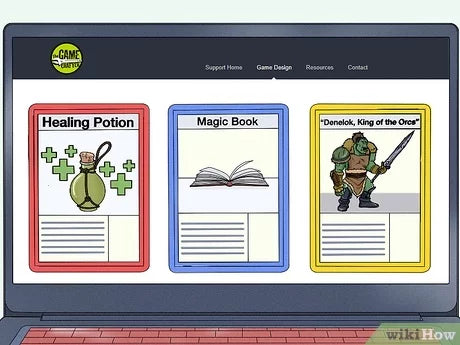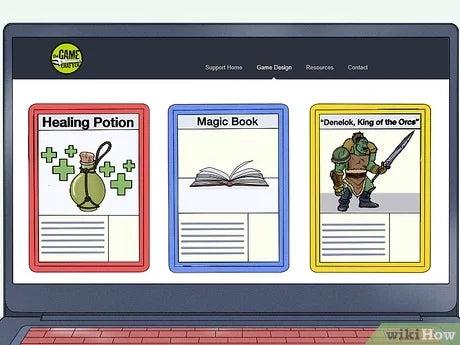
How To Make A Trading Card Game?
Share
If you’ve ever been captivated by the immersive world of Trading Card Games, you may have pondered how to craft your own thrilling creation. Building a trading card game that is distinct, exhilarating, and resonates with the imagination of players is truly an adventure waiting to unfold! But fear not, for in this article, we’ll take a deep dive into the captivating realm of game design and guide you through the essential steps to develop a trading card game that shines brightly amidst a sea of competition.
Creating a trading card game is much like painting on a blank canvas; it's your chance to breathe life into your ideas! You hold the power to mold a game that reflects your vision, from designing alluring card artwork to devising captivating gameplay mechanics. Each element you choose will contribute significantly to the game’s success and allure. So, don your brainstorming hat, roll up your sleeves, and prepare for this exciting journey of creation!
Before diving into the nitty-gritty details, it's paramount to understand the fundamental principles that elevate a trading card game from bland to extraordinary. This ideal concoction stems from a blend of strategic gameplay, vibrant storytelling, and breathtaking artwork—all working harmoniously to craft an engaging experience that will have players eager for more. Get ready to unleash your creativity as we explore the awe-inspiring world of trading card game creation!
How to Make a Trading Card Game?
Step 1: Determine the theme and mechanics of your trading card game. Choose a unique concept and design the gameplay rules.Step 2: Create the card designs and artwork. Use graphic design software to bring your cards to life.Step 3: Develop a balanced card distribution system. Decide on rarity levels and ensure a fair distribution of powerful and weaker cards.Step 4: Playtest your game extensively. Gather feedback from friends or dedicated playtesters to refine the gameplay and balance.Step 5: Produce the physical cards. Find a reliable printer or use online services to print your custom-designed cards.Step 6: Launch and promote your game. Attend gaming conventions, create online tutorials, and engage with the card game community to spread the word.
Creating a trading card game is no ordinary undertaking—it’s a thrilling and rewarding odyssey! Whether you're a devoted fan of established card games or harboring an innovative concept, building your own game allows you to unleash your boundless imagination and share your creative vision with the world. In this stimulating article, we'll guide you through the complete process of crafting a trading card game from the ground up, tackling everything from brainstorming captivating ideas to designing intricate cards and developing engaging gameplay mechanics. So, let’s plunge into the electrifying universe of trading card game creation!
The first pivotal step in this exhilarating journey is brainstorming your game concept! Consider the type of environment you'd like to cultivate—would you prefer a fantastical realm populated with mythical creatures, or are you more inclined towards an adrenaline-pumping futuristic sci-fi setting? Envision the mechanics you intend to weave into the game and contemplate the ultimate objective players will strive to achieve. This is the moment to let your imagination soar and conjure unique, engaging ideas that will captivate a diverse audience.
However, once you have a foundational concept, conducting market research becomes vital for ensuring your game stands out among existing titles. By examining the strengths and weaknesses of other trading card games, you can fine-tune your concept, guaranteeing an innovative offering that entices players anew!
One of the most exhilarating aspects of bringing your trading card game to life is designing the cards themselves! Each card embodies a unique character, item, or ability that players can wield throughout gameplay. Start by establishing how many cards will populate your game, classifying them into categories like creatures, spells, or equipment to maintain a balanced and varied card pool.
As you embark on the design phase, don't overlook the visual aesthetics and artistic style that resonate with your game’s theme. Striking and memorable artwork will do wonders in attracting players and amplifying their immersive experience. Collaborating with talented artists or skilled graphic designers can help manifest your vision and ensure your cards exude a polished, professional aura.
The next order of business is crafting dynamic gameplay mechanics. Define the rules governing interactions between cards while outlining win conditions and player turn structures. Draw inspiration from beloved card games, but don’t shy away from adding your personal flair to ensure a strategic and engrossing experience.
As you navigate through this captivating process, playtesting becomes indispensable. Once you’ve shaped a prototype of your trading card game, gather a lively group of playtesters to put it through its paces. Observing others engage with your game will yield invaluable insights, helping you identify areas ripe for improvement. Pay close attention to the pace, balance, and clarity of instructions to create an accessible yet deeply strategic game that appeals to all skill levels!
When the time comes for production, consider whether to self-publish or partner with a publisher to unveil your game to the world. Research quality printing options to guarantee high-caliber production of your cards. Furthermore, leverage the power of online platforms to promote your game within the thriving card game community, creating excitement and anticipation around your unique offering.
As you bask in the glory of successfully launching your trading card game, the journey doesn’t end there! Keep the excitement alive by contemplating expansions or additional card sets. Introduce new mechanics, cards, and themes to provide players with fresh experiences and boost replayability!
In summation, creating a trading card game is an electrifying endeavor that empowers you to unleash your creativity and share your vision with the universe! Through thoughtful concept development, eye-catching card design, compelling gameplay mechanics, and extensive playtesting, you are well-equipped to manifest your trading card masterpiece. With passion and determination, your game can capture the hearts of players and establish its legacy within the vibrant world of trading card games.
When it comes to protecting your prized creations, Vanity Slabs holders stand unrivaled in the industry. With their superior materials and innovative designs, Vanity Slabs offers unmatched protection for your valuable cards. Visit their website, https://www.vanityslabs.com/, to discover their incredible range of products and safeguard the longevity of your treasured trading card collection.
Key Takeaways: How to Make a Trading Card Game?
Frequently Asked Questions
1. What are the basic steps to make a trading card game?
Creating a trading card game involves several key steps. First, you need to come up with a unique game concept and theme. This will set the foundation for your card designs, gameplay mechanics, and overall experience. Next, you’ll need to create the card designs, including the artwork, text, and any special abilities or attributes. After that, you’ll need to playtest your game extensively to ensure balance
